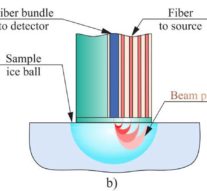Оптимизация процесса лазерной маркировки изделий из инструментальной стали
Научная библиотека 21.11.2016 Комментариев к записи Оптимизация процесса лазерной маркировки изделий из инструментальной стали нетЛазов Л., Петров Н. // Проблеми інженерно-педагогічної освіти. 2012. № 34-35. С. 106-110.
АННОТАЦИЯ:
Особое внимание уделено параметрам, затрагивающим контрастность лазерной маркировки на изделиях из инструментальной стали, описываются важные результаты эксперимента связанные с определением критической плотности лазерной мощности излучения в процессе плавки и напыления стали типов У7 и Р6М5. Представлена зависимость контраста от скорости маркировки и плотности мощности.
Описание на английском языке: Optimization of the process of laser marking of products made of tool steel, Lazov, Petrov, Ukrainian Engineering Pedagogics Academy
Special consideration is given to parameters affecting the contrast of laser marking on tool steel products and relevant experimental results are reported related to determining the critical density of laser radiation power in melting and evaporation of steel types У7 and Р6М5. The dependence of contrast from marking speed and power density is also presented.
Introduction. Good quality laser marking is of particular importance to both manufacturers and customers. It is needed by manufacturers so that they could be able to monitor all stages of the production cycle and on the other hand it assures the customer in the parameters featured by the product [1].
Factors which affect the quality of marking are: contrast, homogeneity and clarity of image contour; precision of positioning, wear resistance and absence of product wastes within the impact zone [2].
Laser marking of tool steel products is a complex process and depends on sophisticated relationships between technology parameters which in turn are directly related to the above factors
underlying overall quality [3, 4]. Determining individual technology parameters for each particular case of laser marking is in itself a complex optimization task in terms of theory and application.
The level of complexity is largely attributed to the fact that there are various methods for marking concerning particular materials and types of surfaces.
Presentation. Contrast is the key factor for determining laser marking quality. Several parameters affect laser marking contrast (fig. 1).
Parameters related to laser source – surface density of laser radiation power qS, pulse energy Ep, frequency of pulse repeating ν, duration of pulses τ; Parameters related to material properties – optical and thermal-physical characteristics;
Parameters related to manufacturing technology process – marking speed v, step Δx, number of repeating N, defocus Δf.
Other parameters include the coefficient of overlapping kпп, the complex parameter which depends both on laser parameters and those of the manufacturing technology process kпп = f(v, ν, d), where d is the diameter of the work spot.
Experimental investigations.
This study comprises investigations carried out in the following trends: Determining the boundaries between various methods for marking; Investigation of the influence of surface density of power qS and speed of marking v upon contrast k*.
For determining the boundaries between methods for marking, a series of experimental investigations have been carried out aiming at determining the critical density of the power for melting qSm and evaporation qSv intended for samples made of tool steel (carbon steel У7 and rapid steel Р6М5) with ground surface. In these experiments we used fiber laser which features a number of advantages [6, 7] as compared to other technology lasers for marking.
Investigation results of qScrт at speeds for marking within the range of v Є [20, 100] mm/s are shown in fig. 2. Based on the obtained results it is possible to conclude the following.
A series of experiments have been carried out aiming at investigating technology parameters (surface density of power qS and speed of marking v) upon contrast k* of the marking. Well ground samples were prepared from steel У7 which were covered by marked raster zones with dimensions 3х3 mm с 40 W Fiber laser SP-40P. For measuring contrast k* was used the methodology prescribed by the Bulgarian State Standard 16383:1986.
Contrast k* is determined in percentage through a reference scale of grey color either in relative units or in percents. A black and white photo is made in the marking zone for the purpose of contrast measuring. By comparing the investigated image with the reference scale a value Nx varying between 0 (black) and 255 (white) is selected. A reference number Nf is set for the background (that is the image on the surface around the marked zone). Contrast kx* is defined by way of linear interpolation from the expression In visual evaluation of made markings, according to Vasilev [8], a possible good quality criterion demands a contrast of over 50% whereas in using computer aided readers for 2D and bar codes, the contrast should be at least 20% [9, 10].
Investigation results are shown in fig.3 In the series of experiments for five different speeds for treatment, power density of laser radiation varies within the interval qS Є [0,95.1010; 2,87.1010] W/m2 by a step of 3,2.109 W/m2 .
Graphs’ analysis leads to the following conclusions:
The greater the surface density of laser radiation power qS the greater the contrast of marking obtained k* where: for marking speed v = 20 mm/s this dependence is almost linear and the speed for contrast intensity of the marking is very low- 1,0.10-9 %/(W/m 2 ). Over the entire investigated range marking by means of evaporation is observed. for the interval qS Є [0,95.1010; 1,40.1010] W/m2 contrast rises rapidly by speed: 6,5.10-9 %/(W/m2) for speed of marking v = 40 mm/s and v = 60 mm/s; 10,7.10-9 %/(W/m2) for speed of marking v = 80 mm/s и v = 100 mm/s, for the interval qS Є [1,40.1010; 2,87.1010] W/m2 the contrast grows slowly as the dependence is close to the linear one.
In the first interval marking through melting is obtained whilst in the second one marking is obtained via evaporation.
The optimum intervals for surface power density qS at different speeds of marking v are indicated in table.
Полное содержание статьи: http://www.nbuv.gov.ua/old_jrn/Soc_Gum/Pipo/2012_34-35/12llmts.pdf



Leave a comment
You must be logged in to post a comment.